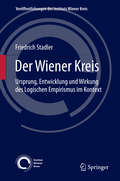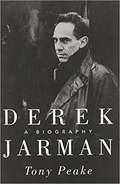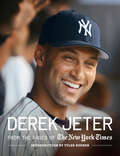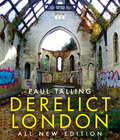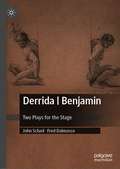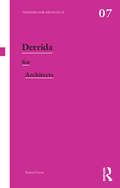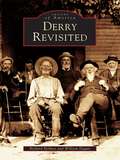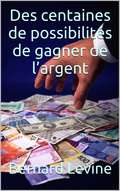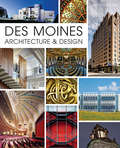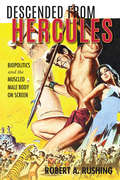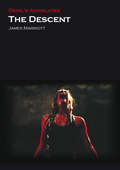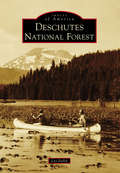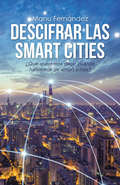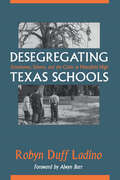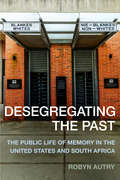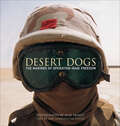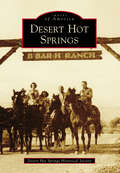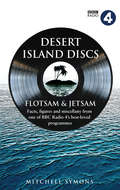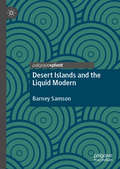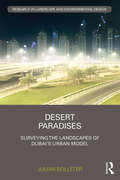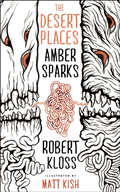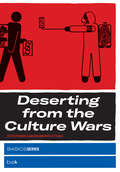- Table View
- List View
Der Wiener Kreis
by Friedrich StadlerDie zweite Auflage dieses inzwischen vergriffenen Buches (1. Auflagen Suhrkamp 1997/2001) stellt die einzige Gesamtdarstellung und Dokumentation des Wiener Kreises im historischen Kontext dar. Es liefert eine wissenschaftsgeschichtliche und systematische Untersuchung zum Logischen Empirismus des Wiener Kreises, der bis heute als bahnbrechende Strömung wissenschaftlicher und analytischer Philosophie eine internationale Berühmtheit erlangt hat. Nach der Vorgeschichte des Wiener Kreises in der Monarchie wird das geistige Umfeld der ,,Spätaufklärung" in der Ersten Republik als Grundlage für die Entwicklung des Schlick-Zirkels (mit der Publikation der Protokolle), sowie des Vereins Ernst Mach und Karl Mengers Mathematisches Kolloquium dargestellt. Die interne und externe Entwicklung dieser Gruppe wird bis zum ,,Anschluss" 1938 beschrieben, die einerseits durch einen blühenden Aufstieg mit wachsender Anerkennung im Ausland, andererseits durch die Vertreibung aus ihrer Heimatstadt charakterisiert ist. Dabei wird auf der Basis von Primärquellen das Verhältnis des Wiener Kreises zu den wichtigsten Bezugspersonen wie Ludwig Wittgenstein, Heinrich Gomperz und Karl Popper (mit einem Interview) neu dargestellt, sowie der Pluralismus des Kreises am Beispiel von Otto Neurath und Moritz Schlick illustriert. Der dokumentarische Teil bietet eine biografische und bibliografische Gesamtschau des Wiener Kreises und seiner Peripherie auf dem aktuellsten Stand der Forschung sowie die erste quellenorientierte Dokumentation zur folgenreichen Ermordung von Moritz Schlick im Jahre 1936. Das Buch stellt ein Standardwerk zur Geschichte des Wiener Kreises dar, der für die damalige europäische Wissenschaftsphilosophie und ihre Wirkung in der heutigen analytischen philosophy of science exemplarisch ist.
Derek Jarman: A Biography
by Tony PeakeTaken decade by decade, Derek Jarman's life is a virtual encapsulation of the social and cultural history of the latter half of the twentieth century, from post-war austerity through the liberated sixties and the perplexing seventies to the eighties of Aids and Thatcherism.Always influential in artistic and film-making terms, and within the gay community, Jarman had attained before his death a figurehead status that is now very generally recognised, and can only increase with time. His extraordinary garden in Dungeness in Kent has become a major tourist attraction and his films still compel massive critical attention. Tony Peake was Derek Jarman's literary agent, and knew him well. His authorised biography is based on first-hand interviews and primary research and does immense justice to a brilliant - and singular - subject.
Derek Jeter: From the Pages of The New York Times
by The New York TimesThis beautifully illustrated volume celebrates the career of the legendary Yankee shortstop featuring iconic full-color images from The New York Times.After twenty major league seasons—all with the New York Yankees—Derek Jeter retired from the game at the conclusion of the 2014 campaign. The Yankees’ captain since 2003, the shortstop is considered the greatest Yankee of his generation. Jeter’s teams won five World Series, including three in a row in 1998, 1999, and 2000. The all-time postseason leader in hits, doubles, and triples, Jeter earned the nickname “Captain Clutch” for his game-changing performances during the Yankees’ championship era. Through stories and powerful images from the pages of the New York Times, Derek Jeter: Excellence and Elegance celebrates the career of this New York icon from Jeter’s debut in 1995 through his final game in 2014. This full-color pictorial keepsake also features an introduction by Tyler Kepner, the Times’ award-winning baseball reporter.
Derelict London: All New Edition
by Paul Talling______________________________The huge word-of-mouth bestseller – completely updated for 2019THE LONDON THAT TOURISTS DON’T SEELook beyond Big Ben and past the skyscrapers of the Square Mile, and you will find another London. This is the land of long-forgotten tube stations, burnt-out mansions and gently decaying factories. Welcome to DERELICT LONDON: a realm whose secrets are all around us, visible to anyone who cares to look . . . Paul Talling – our best-loved investigator of London’s underbelly – has spent over fifteen years uncovering the stories of this hidden world. Now, he brings together 100 of his favourite abandoned places from across the capital: many of them more magnificent, more beautiful and more evocative than you can imagine.Covering everything from the overgrown stands of Leyton Stadium to the windswept alleys of the Aylesbury Estate, DERELICT LONDON reveals a side of the city you never knew existed. It will change the way you see London. ______________________________PRAISE FOR THE DERELICT LONDON PROJECT‘Fascinating images showing some of London’s eeriest derelict sites show another side to the busy, built-up capital.’ Daily Mail‘Talling has managed to show another side to the capital, one of abandoned buildings that somehow retain a sense of beauty.’ Metro‘Excellent . . . As much as it is an inadvertent vision of how London might look after a catastrophe, DERELICT LONDON is valuable as a document of the one going on right in front of us.’ New Statesman‘From the iconic empty shell of Battersea Power Station to the buried ‘ghost’ stations of the London Underground, the city is peppered with decaying buildings. Paul Talling knows these places better than anyone in the capital.’ Daily Express‘[London has an] unusual (and deplorable) number of abandoned buildings. Paul Talling’s surprise bestseller, DERELICT LONDON, is their shabby Pevsner.’ Daily Telegraph______________________________
Derrida | Benjamin: Two Plays for the Stage
by John Schad Fred DalmassoWithin the work of both Jacques Derrida and Walter Benjamin there is a buried theatricality, a theatre to-come. And in the last fifteen years there has been a growing awareness of this theatricality. To date, though, there has not been a published stage play about either Derrida or BenjaminCue Derrida| Benjamin, a volume that brings together two tragi-comic plays which mirror each other in a host of ways – above all, in the way that the central philosophical figure is displaced, or not quite where or when we would expect to find them. In Derrida’s case, it is Oxford in 1968; in Benjamin’s case, it is somewhere (or nowhere) near London in 1948. These, then, are plays in which the philosopher is exiled, or elsewhere – not quite himself. This a volume for anyone with an eye or ear for where theatre or performance meets philosophy – students, scholars, readers, actors.
Derrida for Architects (Thinkers for Architects)
by Richard CoyneLooking afresh at the implications of Jacques Derrida’s thinking for architecture, this book simplifies his ideas in a clear, concise way. Derrida‘s treatment of key philosophical texts has been labelled as "deconstruction," a term that resonates with architecture. Although his main focus is language, his thinking has been applied by architectural theorists widely. As well as a review of Derrida’s interaction with architecture, this book is also a careful consideration of the implications of his thinking, particularly on the way architecture is practiced.
Derry Revisited (Images of America)
by Richard Holmes William DuganIn 1719, sixteen families left Ireland for America and founded a community called Nutfield, which evolved into modern Derry. For centuries, Derry retained its small-town character, but the 1963 opening of Interstate 93 changed the town forever. Within a decade, its population doubled. Derry is now the state's most populous town. This charming collection of over two hundred photographs presents Derry in its quieter years, when trolleys crisscrossed the town, most of the men worked in shoe factories, and traffic on Broadway stopped each morning as the Hood cows crossed to their pasture. For many older residents, these images will bring back a flood of memories. Newcomers will better understand the traditions that helped shape the town. Derry Revisited evokes a sense of expanded pride in the heritage of Derry.
Des centaines de possibilités de gagner de l’argent
by Victor Thivillier Bernard LevineCe livre unique va vous donner des centaines de différents moyens de gagner de l'argent. Si vous souhaitez recevoir un revenu complémentaire... Si vous voulez plus d'argent entrant dans votre compte bancaire chaque mois... Alors ce livre peut vous sauver la vie. Il y a tellement de moyens de gagner de l'argent sur votre temps libre, en faisant ce à quoi vous êtes bon, et ce que vous aimez. Il y a ici des solutions pour tout le monde! Bon nombre de ces possibilités de revenus légitimes vous permettront de remplir votre portefeuille ou votre sac à main, sans avoir à bouger de chez vous. Pour obtenir un flux régulier d'argent dans votre vie, vous devez avoir le savoir-faire et la connaissance de ce qui est nécessaire pour y arriver. Vous avez besoin de connaître les noms des entreprises qui peuvent vous payer. Vous devez avoir plusieurs flux de revenus et sources d'argent virés continuellement sur votre compte bancaire. Et il y a plus d'une façon de gagner de l'argent. La clef du succès réside dans les opportunités que vous provoquez vous-même. Vous êtes à seulement quelques minutes de commencer sur la voie qui vous permettra de recevoir de l'argent régulièrement sur votre compte bancaire. Alors qu'attendez-vous... Ce livre unique vous donnera des centaines de différents moyens et idées pour générer un flux continu de revenu supplémentaire dans votre vie! ...Choisissez Les opportunités que vous préférez et commencez à générer du revenu!
Des Moines Architecture & Design
by Jay PridmoreDes Moines boasts a remarkable architectural portfolio rich in depth and quality. The town drew wide attention in the nineteenth century with structures like the Iowa State Capitol and the Terrace Hill mansion. Des Moines embraced the City Beautiful movement in the twentieth century and became home to well-known work by Eliel and Eero Saarinen, notably the city's innovative Art Center. A contemporary architectural renaissance produced lauded landmarks like the Meredith Headquarters, the Des Moines Public Library and the John and Mary Pappajohn Sculpture Park. Author Jay Pridmore crafts an illustrated survey of the architecture and design of Iowa's largest city.
Descended from Hercules: Biopolitics and the Muscled Male Body on Screen
by Robert A. RushingMuscles, six-pack abs, skin, and sweat fill the screen in the tawdry and tantalizing peplum films associated with epic Italian cinema of the 1950s and 1960s.Using techniques like slow motion and stopped time, these films instill the hero's vitality with timeless admiration and immerse the hero's body in a world that is lavishly eroticized but without sexual desire. These"sword and sandal" films represent a century-long cinematic biopolitical intervention that offers the spectator an imagined form of the male body--one free of illness, degeneracy, and the burdens of poverty--that defends goodness with brute strength and perseverance, and serves as a model of ideal citizenry.Robert A. Rushing traces these epic heroes from Maciste in Cabiria in the early silent era to contemporary transnational figures like Arnold Schwarzenegger in Conan the Barbarian, and to films such as Zach Snyder's 300.Rushing explores how the very tactile modes of representation cement the genre's ideological grip on the viewer.
The Descent (Devil's Advocates)
by James MarriottThe story of an all-female caving expedition gone horribly wrong, The Descent (2005) is arguably the best of the mid-2000s horror entries to return verve and intensity to the genre. Unlike its peers (Saw [2004], Hostel [2011], etc.), The Descent was both commercially and critically popular, providing a genuine version of what other films could only produce as pastiche. For Mark Kermode, writing in the Observer, it was "one of the best British horror films of recent years," and Derek Elley in Variety described it as "an object lesson in making a tightly-budgeted, no-star horror pic." Time Out's critic praised "this fiercely entertaining British horror movie;" while Rolling Stone's Peter Travers warned prospective viewers to "prepare to be scared senseless." Emphasizing female characters and camaraderie, The Descent is an ideal springboard for discussing underexplored horror themes: the genre's engagement with the lure of the archaic; the idea of birth as the foundational human trauma and its implications for horror film criticism; and the use of provisional worldviews, or "rubber realities," in horror.
The Descent
by James MarriottThe story of an all-female caving expedition gone horribly wrong, The Descent (2005) is arguably the best of the mid-2000s horror entries to return verve and intensity to the genre. Unlike its peers (Saw [2004], Hostel [2011], etc.), The Descent was both commercially and critically popular, providing a genuine version of what other films could only produce as pastiche. For Mark Kermode, writing in the Observer, it was "one of the best British horror films of recent years," and Derek Elley in Variety described it as "an object lesson in making a tightly-budgeted, no-star horror pic." Time Out's critic praised "this fiercely entertaining British horror movie;" while Rolling Stone's Peter Travers warned prospective viewers to "prepare to be scared senseless." Emphasizing female characters and camaraderie, The Descent is an ideal springboard for discussing underexplored horror themes: the genre's engagement with the lure of the archaic; the idea of birth as the foundational human trauma and its implications for horror film criticism; and the use of provisional worldviews, or "rubber realities," in horror.
The Descent
by James MarriottThe story of an all-female caving expedition gone horribly wrong, The Descent (2005) is arguably the best of the mid-2000s horror entries to return verve and intensity to the genre. Unlike its peers (Saw [2004], Hostel [2011], etc.), The Descent was both commercially and critically popular, providing a genuine version of what other films could only produce as pastiche. For Mark Kermode, writing in the Observer, it was "one of the best British horror films of recent years," and Derek Elley in Variety described it as "an object lesson in making a tightly-budgeted, no-star horror pic." Time Out's critic praised "this fiercely entertaining British horror movie;" while Rolling Stone's Peter Travers warned prospective viewers to "prepare to be scared senseless." Emphasizing female characters and camaraderie, The Descent is an ideal springboard for discussing underexplored horror themes: the genre's engagement with the lure of the archaic; the idea of birth as the foundational human trauma and its implications for horror film criticism; and the use of provisional worldviews, or "rubber realities," in horror.
Deschutes National Forest: Deschutes And Willamette National Forests, Oregon (Images of America)
by Les JoslinFrom the crest of the High Cascades eastward to the High Desert, the Deschutes National Forest is one of America’s great national treasures. Timber, water, and forage were plentiful in Central Oregon and provided the building blocks for the region. Today, the national forest’s scenery and year-round outdoor recreational resources play major roles in sustaining a vibrant and diverse modern economy and a unique way of life. Since 1905, these resources have been administered by the US Forest Service, fulfilling its mission to pursue “the greatest good of the greatest number in the long run,” as decreed by forester Gifford Pinchot when he led the fledgling agency.
Descifrar las smart cities: ¿Qué queremos decir cuando hablamos de smart cities?
by Manu Fernández¿Qué queremos decir en realidad cuando hablamos de smart cities? <P><P>La smart city se ha convertido en un nuevo modelo urbano para pensar y diseñar las ciudades en la sociedad conectada. <P>El creciente interés por las ciudades y su sofisticación tecnológica nos invita a comprender el impacto y las consecuencias de cuestiones como el big data, el urbanismo cuantitativo, las tecnologías cívicas o la regulación algorítmica. <P> El presente libro quiere ofrecer preguntas y cuestionamientos críticos sobre el significado de las ciudades inteligentes y cómo darles un contexto urbano.
Descubriendo a Coco
by Edmonde Charles-RouxLa vida intensa de una mujer que revolucionó la moda y la vida social del siglo XX: Coco Chanel. Narrar la vida de una persona que ha dejado solo unos pocos testimonios y que se ha preocupado por falsear una y otra vez su propia biografía no es una tarea sencilla. La intención de Charles-Roux, que escribió este texto a los pocos años de morir la artista, es ir más allá de la leyenda, y para eso decide aportar minuciosos datos biográficos pero también ahondar en las mentiras y contradicciones de esta gran dama. Su retrato de Chanel muestra el lado más genial y creativo de la diseñadora, y a la vez el más cruel, oportunista y oscuro. Plasmada en toda su complejidad y sus contradicciones, Chanel suscita una mezcla de admiración y rechazo, pero nunca indiferencia. Repleta de anécdotas, su biografía se enlaza con la de aquellas figuras que jugaron un papel importante en su vida y su época. Un retrato cabal de la mujer y de la artista que cambió la historia de la moda, y también de la época que le tocó en suerte; desde sus inicios como costurera en Moulins hasta su fallecimiento en 1971, pasando por su consolidación como Coco Chanel, las relaciones que mantuvo con figuras como Picasso, Cocteau, Stravinski o Collete y la Segunda Guerra Mundial, el inicio de un período oscuro en el que participó en una operación de espionaje alemán.
Desegregating Texas Schools: Eisenhower, Shivers, and the Crisis at Mansfield High
by Robyn Duff LadinoIn the famous Brown v. the Board of Education decisions of 1954 and 1955, the United States Supreme Court ruled that "separate but equal" schools for black and white students were unconstitutional. Yet history records that it took more than a decade of legal battles, civil rights protests, and, tragically, violent confrontations before black students gained full access to previously white schools. Mansfield, Texas, a small community southeast of Fort Worth, was the scene of an early school integration attempt. In this book, Robyn Duff Ladino draws on interviews with surviving participants, media reports, and archival research to provide the first full account of the Mansfield school integration crisis of 1956. Ladino explores how power politics at the local, state, and federal levels ultimately prevented the integration of Mansfield High School in 1956. Her research sheds new light on the actions of Governor Allan Shivers—who, in the eyes of the segregationists, actually validated their cause by his political actions—and it underscores President Dwight Eisenhower's public passivity toward civil rights during his first term of office. Despite the short-term failure, however, the Mansfield school integration crisis helped pave the way for the successful integration of Central High School in Little Rock, Arkansas, in 1957. Thus, it deserves a permanent place in the history of the civil rights movement, which this book amply provides.
Desegregating the Past: The Public Life of Memory in the United States and South Africa
by Robyn AutryAt the Apartheid Museum in Johannesburg, South Africa, visitors confront the past upon arrival. They must decide whether to enter the museum through a door marked "whites" or another marked "non-whites." Inside, along with text, they encounter hanging nooses and other reminders of apartheid-era atrocities. In the United States, museum exhibitions about racial violence and segregation are mostly confined to black history museums, with national history museums sidelining such difficult material. Even the Smithsonian's National Museum of African American History and Culture is dedicated not to violent histories of racial domination but to a more generalized narrative about black identity and culture. The scale at which violent racial pasts have been incorporated into South African national historical narratives is lacking in the U.S. Desegregating the Past considers why this is the case, tracking the production and display of historical representations of racial pasts at museums in both countries and what it reveals about underlying social anxieties, unsettled emotions, and aspirations surrounding contemporary social fault lines around race. Robyn Autry consults museum archives, conducts interviews with staff, and recounts the public and private battles fought over the creation and content of history museums. Despite vast differences in the development of South African and U.S. society, Autry finds a common set of ideological, political, economic, and institutional dilemmas arising out of the selective reconstruction of the past. Museums have played a major role in shaping public memory, at times recognizing and at other times blurring the ongoing influence of historical crimes. The narratives museums produce to engage with difficult, violent histories expose present anxieties concerning identity, (mis)recognition, and ongoing conflict.
Desert Dogs: The Marines of Operation Iraqi Freedom
by Russ Bryant Amy Goodpaster StrebeA photographic account that highlights the human side of war, the day-in-the-life of US Marines stationed in Iraq.Desert Dogs includes dramatic, harrowing, and simply unbelievable images of the marines of Operation Iraqi Freedom, personal letters, and stories of coping with the pain of separation from their families and the horrors of war. Russ Bryant’s photography chronicles every aspect of the daily lives of these marines: lazy camels amble by a cargo drop; blinding sandstorms threaten to blow away tents, supplies, and marines alike; Scud missile attack sirens send marines scuttling to their bunkers; sniper fire crisscrosses marine convoys moving into Iraq; tanks and bombs topple the portraits of Saddam that seem to loom over every Iraqi village; shelled-out tanks, armored vehicles, and even busses litter the road on the way to Baghdad; medical personnel attend to fallen marines and prisoners alike; the occasional silent interlude allows time for prayer and remembrance.
Desert Hot Springs
by Desert Hot Springs Historical SocietyCabot Yerxa's discovery of natural hot and cold mineral water in 1914 was the impetus for the establishment of Desert Hot Springs. His eccentric pueblo-style home, which is listed in the National Register of Historic Places, is a unique tourist attraction. L.W. Coffee also recognized the value of the hot water, so he drilled wells and opened his famous bathhouse in 1941. The development of more than 200 spas followed. Angel View Children's Hospital, established in the 1950s, uses the therapeutic water to treat disabled children. The city's extraordinary, pure cold water wins awards such as "best tasting in the world." Desert Hot Springs is the location of architect John Lautner's first desert commission, and Mary Pickford's house still stands at the famous B-Bar-H Ranch that was frequented by movie stars during the 1940s and 1950s. The historic Two Bunch Palms Resort and Spa is known as an exclusive celebrity hideaway. The city, believed to have an unusually strong vortex, is located just south of Joshua Tree National Park. An elevation of 1,200 feet affords most residents magnificent views of both Mount San Jacinto and Mount San Gorgonio.
Desert Island Discs: Fascinating facts, figures and miscellany from one of BBC Radio 4’s best-loved programmes
by Mitchell SymonsFlotsam & Jetsam is the ultimate trivia book for fans of the popular BBC Radio 4 programme Desert Island Discs, and a fascinating introduction for all those who have yet to discover its delights.Taking the reader through seven decades of wonderful entertainment, here is an absorbing range of facts, figures and miscellany – including who chose what, and why. It also reveals much about the castaways' drives and motivations, their influences and, of course, their lives.Spanning the early years with the original presenter, Roy Plomley, and the present day, the Desert Island Discs programme has brought its own unique surprises to listeners, some very personal, some humorous, such as Eric Morecambe's choice of a deckchair as his luxury and Ernie Wise's of a deckchair ticket machine.From Beethoven to the Beatles, from chessboards and chocolate to Jane Austen and Zola, Flotsam & Jetsam is the perfect companion guide to the national treasure that is Desert Island Discs.
Desert Islands and the Liquid Modern
by Barney SamsonThis book investigates desert islands in postwar anglophone popular culture, exploring representations in radio, print and screen advertising, magazine cartoons, cinema, video games, and comedy, drama and reality television. Drawing on Zygmunt Bauman’s theory of liquid modernity, desert island texts are analysed in terms of their intersections with repressive and seductive mechanisms of power. Chapters focus on the desert island as: a conflictingly in/coherent space that characterises identity as deferred and structured by choice; a location whose ‘remoteness’ undermines satirical critiques of communal identity formation; a site whose ambivalent relationship with ‘home’ and Otherness destabilises patriarchal ‘Western’ subjectivity; a space bound up with mobility and instantaneity; and an expression of radical individuality and underdetermined identity. The desert island in popular culture is shown to reflect, endorse and critique a profoundly consumerist society that seduces us with promises of coherence, with the threat of repression looming if we do not conform.
Desert Paradises: Surveying the Landscapes of Dubai’s Urban Model (Routledge Research in Landscape and Environmental Design)
by Julian BolleterDesert Paradises: Surveying the Landscapes of Dubai’s Urban Model explores how designed landscapes can play a vital role in constructing a city’s global image and legitimizing its socio-political hierarchy. Using the case study of Dubai, Bolleter explores how Dubai’s rulers employ a paradisiacal image of greening the desert, in part, as a tool for political legitimization. Bolleter also evaluates the designed landscapes of Dubai against the principles of the United Nations and the International Federation of Landscape Architects and argues that what is happening in Dubai represents a significant discrepancy between theory and practice. This book offers a new perspective on landscape design that has until now been unexplored. It would be beneficial to academics and students of geography, landscape architecture, urban design and urban planning – particularly those with an interest in Dubai or the many cities in the region that are experiencing Dubaiification.
The Desert Places
by Matt Kish Amber Sparks Robert KlossThe Desert Places is a pocket-sized edition of a hybrid text by Amber Sparks and Robert Kloss that explores the evolution of evil in worlds both seen and unseen and features full-color illustrations by Matt Kish, illustrator of the critically acclaimed Moby-Dick in Pictures: One Drawing for Every Page.
Deserting from the Culture Wars
by Maria Hlavajova Sven LüttickenArtists and writers consider a tactical desertion from the "culture wars"--a refusal to be distracted, an embrace of the emancipatory understanding of culture.Deserting from the Culture Wars reflects upon and intervenes in our current moment of ever-more polarizing ideological combat, often seen as the return of the "culture wars." How are these culture wars defined and waged? Engaging in a theater of war that has been delineated by the enemy is a shortcut to defeat. Getting out of the reactive mode that produces little but a series of Pavlovian responses, this book proposes a tactical desertion from the culture wars as they are being waged today--a refusal to play the other side's war games, an unwillingness to be distracted.
